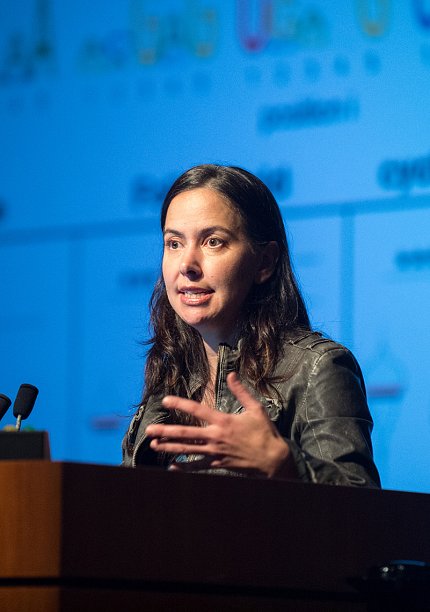Smolke Describes Promise of RNA Sensors, Controllers

Photo: Leslie Kossoff
Her introducer, NIH director Dr. Francis Collins, described Dr. Christina Smolke’s DeWitt Stetten Jr. Lecture on Oct. 23 as “a romp” through a kind of industrial-scale distillation of RNA sensors and controllers via various means.
But there were a lot of “aptamer hammerhead bulges” to be negotiated along the course of the Stanford chemical engineering professor’s hour-long talk.
It was a tongue-in-cheek characterization of basic, preclinical science involving gene-expression control systems that have what Smolke called inherent programmability.
She outlined two scalable platforms for generating RNA switches, a class of genetic switches that are ribozyme-based; they modulate mRNA degradation, meaning they offer hope of turning targeted genes off and on.
Smolke envisions at least four opportunities that are ripe for exploitation if precise off/on control of genes unfolds as hoped:
- Proliferation control for T-cell therapy
- Control over the cell cycle
- Viral infectivity control
- Inducible, or conditional, control over genome editing.
She described the architecture of the switch and ways for applying higher throughput methods based on next-generation sequencing technologies, which can tease out which switches are the most robust.
Two technologies—RNASeq and FACS-Seq—offer the horsepower to assay thousands of candidate sequences in parallel.

Photo: Leslie Kossoff
Each has advantages, but the former takes only 8 days to the latter’s 40, and RNASeq yields data with less noise and is a better predictor of activity of switches inside cells, Smolke said.
In the workflow she described, there is also a validation step that evaluates the functionality of any individual switch.
Because this work is so data-intensive, machine-learning is now being applied to scan huge data sets, Smolke noted.
The big question for biology is whether these switches work in vivo—that is Smolke’s team’s next step.
During a brief Q&A session, she noted that optimizing sensors for a particular cell type will be necessary for any eventual therapy in humans.—Rich McManus
